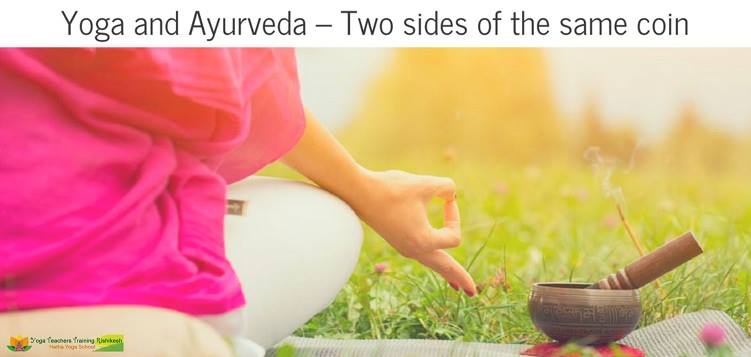Yoga and Ayurveda – Two sides of the same coin
Yoga and Ayurveda are sister Vedic sciences that have been practised for several years to heal the mind, body, and consciousness. In simple words, Ayurveda concerns the health and well-being of the body, while Yoga purifies and harmonizes the mind and consciousness. Both of these ancient practices complement each other.

When practised together, Ayurveda Yoga techniques offer many ways to improve well-being, health, and vitality. Both practices respect and acknowledge the connections between mind, body, and soul. Moreover, Yoga and Ayurvedic treatments mutually support and offer several ways to heal and prevent various disorders by advocating the daily practice of yoga asanas, meditation, breathing techniques, and oils and herbs.
Let’s take a look at some of the similarities between Yoga and Ayurveda.
- Both of these practices are vital to the ancient Vedic texts. Yoga originates from the Yajur Veda, while Ayurveda originates from the Atharva Veda and Rig Veda.
- Both practices emphasize maintaining a healthy body to fulfil the four aims or goals in life: Dharma, Artha, Kama, and Moksha.
- Yoga and Ayurveda training advocates using asana, meditation, diet, mantra, astrology, pooja, prayer, and rituals to heal the body’s well-being.
- Both recognize that maintaining a balance of doshas, dhatus, and malas is vital for having good health.
- Both practices encourage healthy physical as well as emotional, mental and spiritual well-being.
- Yoga and Ayurveda share the same viewpoint on psychology. They understand that the body’s attachment is the cause of all pain and suffering, and ultimate health can be achieved when a person abides in total peace, regardless of the physical body’s state.
- Both of these practices are cleansing methods for our body, which encourage the removal of toxins and waste products through natural means of elimination. Yoga uses Shat Karma, the six purification measures, while Ayurveda uses Panchakarma, the five cleansing actions.
- Both share the same metaphysical physiology and anatomy, consisting of seven main body chakras, five bodily sheaths, and Kundalini Shakti.
Ayurveda health focuses on how the body works through the doshas. Knowing your body’s doshas will help you personalize your yoga regimen accordingly, which will, in turn, help you obtain the best benefits. Yoga helps balance the body’s Vata, Pitta, and Kapha doshas, as several poses offer different effects.
While all forward-bending Yoga poses help with Pitta dosha, twisting yoga postures help with Kapha dosha as they help with better digestion. Besides, backward-bending yoga poses are known to build up heat in the body and, therefore, help balance the Vata Dosha.
Here are some of the Yoga poses recommended for individuals with different constitutions.
- Vata:
People with the vata dosha may experience signs of insomnia or anxiety. Therefore, they should practice slow Yoga poses like Tadasana, Ardha Matsyendrasana, and Sirsasana.
- Pitta:
People with this dosha may have a competitive mentality and anger issues. Hence, they require relaxing yoga poses, such as Ustrasana or Dhanurasana, to help eliminate tension, improve health, and promote compassion.
- Kapha:
People with this dosha may experience congestion, dullness, and procrastination. Therefore, they require yoga poses, such as the Surya Namaskar, Kapalbhati, and Ujjayi Pranayama, to encourage focus and enthusiasm.
